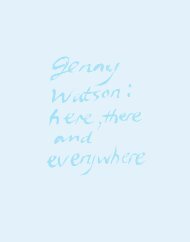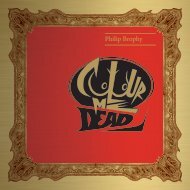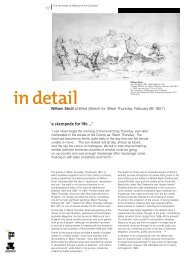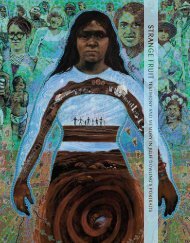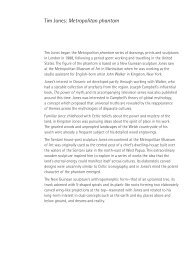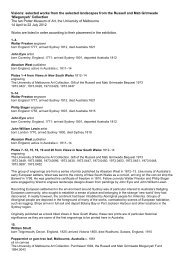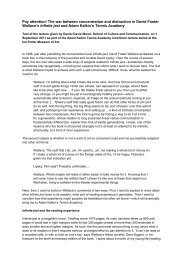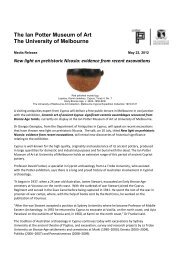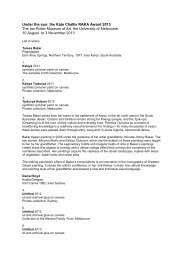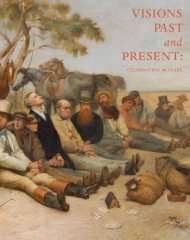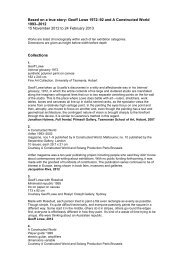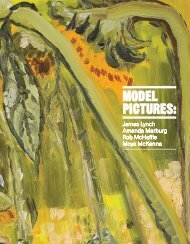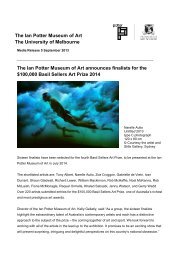The drowned world Jon Cattapan works and collaborations
Catalogue - Ian Potter Museum of Art - University of Melbourne
Catalogue - Ian Potter Museum of Art - University of Melbourne
- No tags were found...
You also want an ePaper? Increase the reach of your titles
YUMPU automatically turns print PDFs into web optimized ePapers that Google loves.
Cat. 65 <strong>The</strong> taking of Richmond 1999<br />
<strong>Cattapan</strong>: When I painted Red system no. 1, I began to<br />
think of those little points of light which represent the<br />
architecture of the city as being not unlike acupuncture<br />
points on a body. I began to think of it as a very bodily sort<br />
of space to be in; you’re in the flow of the vein <strong>and</strong> yet<br />
you’ve still got this kind of screen of information stretched<br />
out over the top of it.<br />
Healy: <strong>The</strong>re’s another aspect of your work that’s in tension<br />
with that. Curtain line (Australian crowd no. 2) [2001]<br />
is a memory work, it’s archiving particular moments in<br />
political <strong>and</strong> cultural history that have been forgotten<br />
in public culture.<br />
<strong>Cattapan</strong>: But part of me always comes back to the<br />
aesthetic. It’s not as if I’m setting out just to work with an<br />
idea or make a point through the work. I think the work has<br />
to be beautiful. So, to me Curtain line has a sort of sensual<br />
quality to it, it’s quite soft.<br />
Burns: <strong>The</strong>re is a possibility that we can find certain kinds<br />
of beauty in those moments of danger. In the visual arts,<br />
the sublime is a particular aesthetic that celebrates terror,<br />
pain <strong>and</strong> fear.<br />
<strong>Cattapan</strong>: I think it’s very important to humanise <strong>and</strong><br />
personalise those events. Carrying [2002] is a work about<br />
the ‘children overboard’ affair. I felt that as the son of<br />
migrants it had a really particular personal resonance for<br />
me. And so, what did I do? I went onto the Internet <strong>and</strong><br />
typed in the words ‘children overboard’ <strong>and</strong> got literally<br />
thous<strong>and</strong>s of references, thous<strong>and</strong>s of picture images<br />
came up. I think it’s a very particular thing to try <strong>and</strong> record<br />
something like that through painting; to actually make a<br />
painting very slowly <strong>and</strong> absorb the event through the<br />
actual act, the physical act of making the work takes it<br />
somewhere else.<br />
Burns: Architectural space encodes all sorts of references<br />
in it to other places <strong>and</strong> spaces. As we move through one<br />
space, the body is living out the memory of other spaces<br />
we’ve visited. And maybe that’s why there’s this dream-like<br />
quality to the paintings, because they make me think of<br />
that process of memory.<br />
Healy: But I think the paintings are also asking: How can<br />
you be a witness to the things that the last hundred years<br />
have seen?<br />
Burns: That’s more apparent in the pieces where the<br />
material is obviously much more political <strong>and</strong> deals with<br />
traumatic events. <strong>The</strong>re’s a kind of anxiety for me if I’m<br />
being asked to witness a particular event but the figures<br />
have lost clarity.<br />
Healy: But aren’t we witnessing very particular<br />
comportments of bodies in the Carbon group<br />
drawings [2003]?<br />
16



